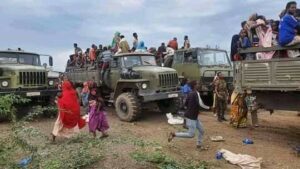A silent but deliberate policy has shaped Ethiopia’s treatment of its Somali population for nearly a century. Successive governments—imperial, socialist, and federal—have all perceived the Somali region and its people as a potential security threat. The result is a history of forced displacement, political exclusion, and economic marginalization centered around one key geographical axis: the Awash–Djibouti corridor, Ethiopia’s vital trade route to the sea.
Today, under Prime Minister Abiy Ahmed’s administration, this policy continues—despite promises of reform and equality under the Prosperity Party.
A Century of the Same Doctrine
The Somali–Afar conflict, one of Ethiopia’s longest-running and bloodiest, has persisted through four distinct regimes—each adopting a different political ideology, yet all reaching the same conclusion: Somali presence in “strategic” areas poses a national security risk.
From Haile Selassie’s monarchy to Mengistu Hailemariam’s Derg, Meles Zenawi’s EPRDF, and Abiy Ahmed’s Prosperity Party, the pattern is clear. Somali communities near major highways, rivers, and border trade routes have been systematically evicted, denied political participation, or administratively absorbed into neighboring regions.
Under Emperor Haile Selassie (1930–1974)
Despite drafting Ethiopia’s first constitution guaranteeing equal rights, Emperor Haile Selassie oversaw mass displacement of Somali pastoralists in the 1950s and 1960s. Thousands were forcibly removed from the Awash–Assab and Awash–Djibouti corridors.
The justification? “Protecting national interests.”
The reality? Marginalizing Somali pastoralists who had inhabited the land for centuries.
The regime also pursued assimilation policies, blending Somali territories into Afar and Oromo administrative structures, effectively erasing Somali political identity from the imperial map.
Under the Derg Military Regime (1974–1991)
The Derg’s socialist ideology promised equality but perpetuated the same discriminatory logic. The junta officially banned Somali communities from living within 35 km of the Awash–Djibouti highway, claiming it was vital for “national defense.”
This order led to mass evictions, extrajudicial killings, and severe restrictions on pastoral mobility. Ironically, while the Derg claimed to represent all Ethiopians, it treated Somali citizens as internal security threats within their own homeland.
EPRDF/TPLF: Federalism Without Justice (1991–2018)
When the Ethiopian People’s Revolutionary Democratic Front (EPRDF) came to power, it introduced ethnic federalism—a system promising self-rule and equal rights for all nations and nationalities.
Yet, in practice, this system excluded Somali communities from strategic territories. In 2004, a so-called “referendum” transferred more than 400 Somali-administered kebeles and major towns into Oromia.
Meanwhile, the West Sitti Zone, including Garba-Issa, Undhufo, and Adaytu, was handed to the Afar region. These areas—all exclusively inhabited by Somalis—were deliberately omitted from the referendum process.
Despite the constitutional promise of equality, the EPRDF’s actions reaffirmed a deeper truth: the Somali people remained excluded from Ethiopia’s political and territorial order whenever “national security” was invoked.
The Prosperity Party and the Myth of Reform (2018–Present)
When Dr. Abiy Ahmed took power in 2018, the Somali people hoped for constitutional justice and recognition. Abiy’s speeches promised to heal divisions, resolve border disputes, and promote regional autonomy.
Instead, under his leadership, the West Sitti crisis deepened.
Thousands of Somali civilians were killed or displaced, villages were burned, and federal forces were deployed—not to protect citizens—but to block access to water, grazing lands, and humanitarian aid.
The Prosperity Party’s approach has effectively revived the old “security doctrine” that treats Somali communities near strategic trade routes as expendable.
National Security or Ethnic Exclusion?
Across all four regimes, Ethiopia’s leaders have viewed the Somali region not as a partner in development but as a liability to be contained. Each government, regardless of ideology, has sought to remove Somalis from areas deemed “strategic,” especially those linked to international trade and security.
This continuity reveals that Ethiopia’s national security strategy functions as an instrument of demographic control, not protection. Somali pastoralists, traders, and farmers have paid the price through loss of land, livelihoods, and life itself.
Conclusion: A Call for Recognition and Justice
From Haile Selassie to Abiy Ahmed, Ethiopia’s state policies have consistently portrayed the Somali people as a security threat rather than citizens with equal rights.
This century-long injustice must end. True national security cannot exist while millions are denied the right to live freely in their ancestral lands.
The Somali people of the West Sitti Zone deserve recognition, constitutional protection, and a voice in shaping their own future.
The international community, human rights organizations, and Ethiopian federal institutions must re-examine this dangerous policy legacy—and act to ensure equality for all citizens, not just those deemed strategically convenient.

